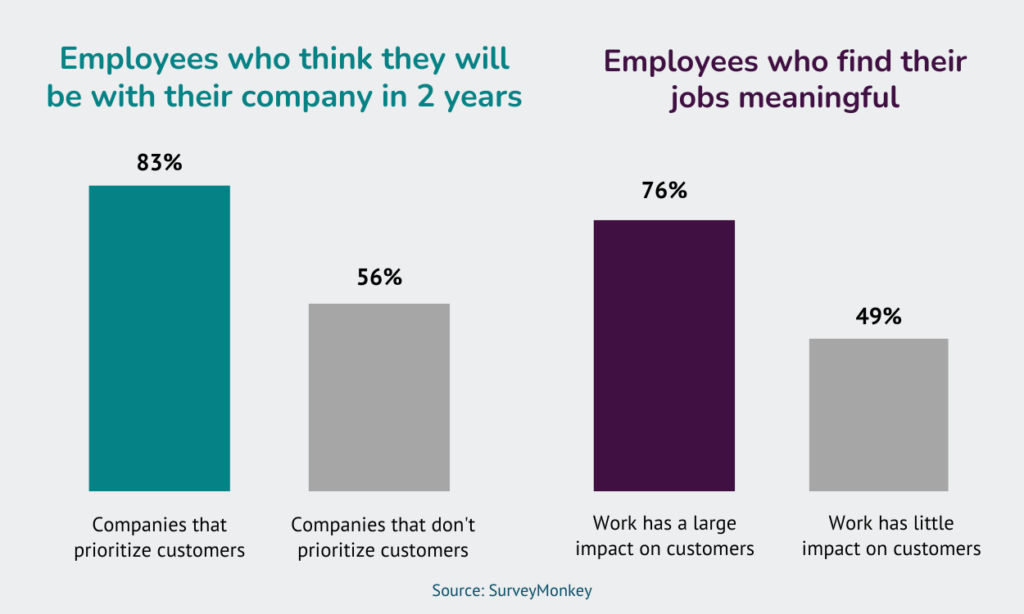Blog Posts
4 Digital Elements for Customer Centricity
4 minute read
4 minute read
Gone are the days of a product-focused company. It’s the customer’s world now.
Consumer behavior has drastically changed in recent years. Customers are harder to obtain, have less brand loyalty, skyrocketing expectations, and fluctuating priorities. More than half of consumers say their expectations are higher than they were even a year ago, and 75% have adjusted their shopping behavior since the pandemic began.
However, this isn’t necessarily bad news. Focusing on ever-changing consumer needs has its perks: increased profitability, brand loyalty, product innovation, and happier employees. Establishing customers as the center of a business—also called customer centricity—is increasing in popularity and opening the gates to organizational success.
Customer centricity is about anticipating customer wants, needs, and preferences. Customer centric companies keep buyers as the focal point of all decisions about delivering products, services, and experiences to foster satisfaction, loyalty, and advocacy.
Customer centricity is not a marketing gimmick and not to be taken lightly. Truly customer centric companies prioritize customers at all levels of the organization and consider how every change will impact them.
Supply chain management used to be about reducing costs and moving products quickly. Now, in this age of disruption, customers have taken a front seat. The rise in customer centricity is so prominent that 50% of supply chain leaders said developing a customer centric culture is their number one customer experience priority.
In a customer centric supply chain, customer feedback, buying patterns, and information are continuously collected, allowing operational leaders to make personalized, agile, and innovative changes throughout the company.
This could mean using predictive analytics based on consumer behavior to determine inventory needed. Or adjusting the manufacturing process to be less environmentally damaging after listening to customer feedback on sustainability issues. Offering buyers multiple delivery options and the ability to track their orders are everyday instances of customer centricity in action.
Though transitioning to a customer centric operating model requires time and money, it pays off. Research from Deloitte shows customer centric companies are 60% more profitable than non-customer centric companies. Organizations that excel at creating personalized experiences for customers also generate 40% more revenue than their peers, according to McKinsey research.
When you think of the biggest and most profitable brands—Apple, Amazon, and Starbucks, for example—they all prioritize customers by listening, enacting meaningful changes, and offering personalized interactions. Customers are viewed as long-term drivers of growth and opportunity, not one-and-done transactions.
It’s no longer enough to offer a valuable product. Brands must go above and beyond to truly impress customers and win loyalty. A way to do this—and a tenant of customer centricity—is through personalization.
Research shows 76% of consumers are more likely to consider purchasing from brands that personalize based on preferences, and 78% also said they’re more likely to make repeat purchases from and recommend companies that personalize.
This pays in two folds. Loyal and engaged customers tend to become return customers. Return customers advocate for brands they love, which helps generate even more business—referred customers are four times more likely to buy when referred by a friend, and 92% of shoppers trust referrals from people they know, according to research from Nielson.
Change driven by customer demand can lead to a company’s best innovation. In 2015, Adidas was facing growing pressure from consumers to adopt sustainable practices. Adidas then began manufacturing shoes from plastic waste found in oceans through a partnership with Parley. In just 3 years, Adidas sold more than a million shoes made from plastic waste, and today, Adidas offers an entire collection of shoes and clothes made from ocean plastic.
For an everyday example of innovation stemming from customers, think of COVID-19. The pandemic was one of the most drastic disruptions to consumer activity in recent history. When life was upended, businesses sprang into action to meet customers where they were, from grocery delivery to at-home exercise and even to-go cocktails. Many of these changes proved successful and are still in place today.
Read: Supply Chain Trends & Insights Report: Innovation
Employees who work for customer centric companies feel their work has meaning and plan to stay with the company for longer, reports SurveyMonkey. Of employees who work for companies that prioritize customers, 83% said they’re likely to still be at the company in two years, compared to 56% for employees whose companies don’t prioritize customers. In a similar trend, among employees who say their work has a large impact on customers, 76% find their jobs meaningful, compared to 49% for those who say their work has little impact on customers.
Empowering employees to make decisions and prioritize customers is a win-win. Workers are more satisfied, and customers have a seat at the table.

Implementing a customer centric operating model is no quick fix, but the benefits are worth it. At Catena Solutions, we specialize in business transformation and data and analytics solutions to modernize operations and provide the leadership needed to achieve customer centricity throughout the business.
Get in touch to learn more.